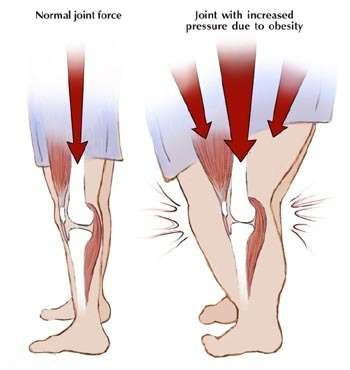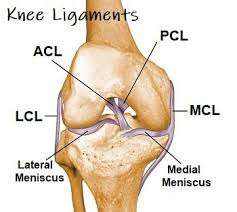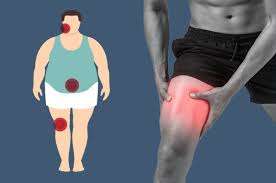Obesity is a growing global concern, with its impacts reaching far beyond just weight.
One of the lesser-discussed consequences of carrying excess weight is the strain it places on the knees, leading to injuries, chronic pain, and even ligament tears.
The knees, being weight-bearing joints, are particularly vulnerable when extra pounds come into play.
This article will explore the hidden connection between knee strain and obesity, and how weight can contribute to various knee injuries, such as anterior ligament tears, medial collateral ligament strains, and more.
“Knee Strain and Obesity” Article Index
- How Obesity Affects Your Knees
- Anterior Ligament Tear and Obesity
- Medial Collateral Ligament Tear and Recovery Time
- Posterior Collateral Ligament Tear: The Impact of Extra Weight
- Treatment for ACL Ligament Tear: Is Weight a Factor?
- MCL Strain Recovery: How Obesity Slows Down Healing
- Knee Joint Ligament Tears: Risk Factors in Obesity
- Pulled Ligaments in the Knee: How Weight Exacerbates Injury
- Preventing Knee Strain Through Ergonomics and Weight Management
- Conclusion: How Obesity and Knee Strain Are Inextricably Linked
How Obesity Affects Your Knees
The knees are complex joints that support most of your body’s weight. When you are overweight or obese, the stress on your knees increases exponentially.
According to the Journal of Orthopaedic Research, for every pound of body weight, your knees experience three to four pounds of pressure when walking.
This means that being just 10 pounds overweight can add an extra 30-40 pounds of stress on your knees with each step. Over time, this additional load can lead to knee injuries, including ligament tears and strains.
The excess strain causes faster wear and tear on the cartilage in your knee joint, contributing to osteoarthritis and other degenerative conditions.
Obesity not only speeds up joint deterioration but also increases the likelihood of ligament injuries, making the connection between knee strain and obesity more significant than many realize.

Anterior Ligament Tear and Obesity
One of the most common knee injuries is an anterior ligament tear, more commonly known as an ACL tear.
The anterior cruciate ligament is crucial for stabilizing your knee, particularly during activities like running, jumping, or sudden changes in direction. Obesity increases the risk of an ACL tear due to the additional stress placed on the knee joint during movement.
A study in the American Journal of Sports Medicine showed that obese individuals are at a higher risk of ACL injuries because the excess weight increases the forces exerted on the ligaments.
When these ligaments are overstressed, they can tear, leading to significant pain and instability in the knee.
Medial Collateral Ligament Tear and Recovery Time
The medial collateral ligament (MCL) runs along the inside of your knee, providing stability. An MCL tear often occurs due to direct blows to the knee, but obesity can increase the risk even without such impact.
When you carry extra weight, the MCL has to work harder to keep the knee stable, which can lead to overuse injuries and strains.
Recovery time for a medial collateral ligament tear can vary based on the severity of the injury, but research from the Journal of Orthopaedics and Traumatology shows that recovery times are generally longer in obese individuals due to the additional stress the knee continues to endure even during the healing process.
For many, MCL strain recovery is delayed by excess weight, leading to prolonged pain and instability.
Posterior Collateral Ligament Tear: The Impact of Extra Weight
The posterior collateral ligament (PCL) is located at the back of the knee and is responsible for preventing the tibia (shinbone) from moving backward.
A PCL ligament tear is less common than an ACL injury but can be just as debilitating. Obesity puts undue stress on the PCL because the ligament has to support a larger load, particularly when walking downhill or climbing stairs.
A posterior collateral ligament tear can result from overexertion caused by excess weight, as the body struggles to maintain balance and stability.
Recovery from a PCL injury often involves physical therapy and weight management, as reducing body weight can alleviate the pressure on the injured ligament and promote faster healing.
Treatment for ACL Ligament Tear: Is Weight a Factor?
Treatment for an ACL (anterior cruciate ligament) tear typically involves surgery followed by a structured rehabilitation program. However, obesity can significantly complicate both the surgical procedure and the recovery process, leading to additional risks and challenges.
Studies published in the British Journal of Sports Medicine have found that obese patients undergoing ACL reconstruction surgery face a higher risk of complications, including infections, poor wound healing, and graft failure.
Excess weight puts increased stress on the knee joint, which can impair the healing process and lead to a longer recovery period compared to individuals with a healthy body weight.
Post-surgical rehabilitation is a crucial component of ACL tear treatment. A well-designed rehabilitation program focuses on restoring strength, flexibility, and stability to the knee while gradually increasing physical activity.
However, obesity can make rehabilitation exercises more difficult due to reduced mobility, joint pain, and the added strain on the healing knee.
Weight management plays a vital role in successful rehabilitation. Losing excess weight can help decrease the load on the knee joint, making movement easier and reducing the risk of reinjury.
Research suggests that even a modest weight loss of 5–10% of body weight can significantly improve knee function and reduce pain.
In addition to physical therapy, patients are often advised to adopt a healthy diet and engage in low-impact strength training exercises, such as swimming or cycling, to aid weight loss without putting excessive pressure on the knee.
Ultimately, addressing obesity as part of ACL tear treatment can lead to better surgical outcomes, faster recovery, and a lower likelihood of future knee problems.
Orthopedic specialists often recommend a multidisciplinary approach, including guidance from nutritionists and physical therapists, to optimize recovery and long-term knee health.
MCL Strain Recovery: How Obesity Slows Down Healing
As mentioned earlier, recovery from an MCL strain can be prolonged by obesity. The additional weight continuously strains the healing ligament, causing more pain and discomfort.
According to the Journal of Rehabilitation Research and Development, weight loss can significantly speed up the recovery process for ligament strains and tears by reducing the mechanical load on the joint.
Furthermore, individuals who are overweight are often less mobile during recovery, leading to muscle atrophy and joint stiffness.
This combination makes MCL strain recovery more challenging for those who are obese.

Knee Joint Ligament Tears: Risk Factors in Obesity
Knee joint ligament tears, including ACL, MCL, and PCL injuries, are all more common in individuals who are obese.
The excess weight puts additional strain on the ligaments, making them more susceptible to injury, even during low-impact activities like walking or standing up from a seated position.
A study in the Journal of Clinical Orthopaedics showed that overweight individuals were more likely to experience ligament tears than their normal-weight counterparts, particularly in high-impact sports or physical activities.
Reducing weight can significantly decrease the risk of ligament tears by lowering the stress placed on the knee joints.
Pulled Ligaments in the Knee: How Weight Exacerbates Injury
A pulled ligament in the knee refers to the overstretching or slight tearing of one of the ligaments that support the knee.
While this injury can happen to anyone, it is more likely in individuals who are obese due to the continuous strain on the ligaments from carrying extra weight.
A lateral meniscus strain, for example, is often caused by twisting or overloading the knee joint. Obesity increases the likelihood of this injury because the meniscus has to support more weight, making it more vulnerable to strain or tearing.
The same is true for all other ligaments in the knee, which are less resilient when constantly overburdened by excess body weight.
Preventing Knee Strain Through Ergonomics and Weight Management
Preventing knee strain in obese individuals involves a combination of weight management and proper body mechanics.
One effective way to reduce knee strain is by adopting the ergonomic way of sitting at a desk. Sitting for prolonged periods can exacerbate knee pain, especially if you are overweight.
Using a chair that supports proper alignment and taking frequent breaks to stand and stretch can help.
Weight management, including regular exercise (such as squats) and a healthy diet (such as weekly diet breaks for recovery), is another critical component of preventing knee strain.
Losing weight reduces the pressure on your knees, making them less vulnerable to ligament injuries. Exercise can also strengthen the muscles around the knee, providing better support for the joint.

How Obesity and Knee Strain Are Inextricably Linked?
In conclusion, the connection between knee strain and obesity is clear.
Carrying extra weight places significant stress on the knee joints, increasing the risk of ligament tears, strains, and chronic pain.
Obesity not only contributes to the development of knee injuries but also slows down the recovery process, making it harder to heal from ligament tears such as anterior ligament tears, medial collateral ligament tears, and posterior collateral ligament tears.
Preventing knee strain requires a multifaceted approach that includes weight management, proper exercise, and the adoption of ergonomic practices in daily activities.
While weight loss can seem daunting, even modest reductions in body weight by consuming healthy weight loss smoothies, can lead to substantial improvements in knee health and a lower risk of injury.
If you are struggling with knee pain or injury and are overweight, addressing your weight is a crucial step in your recovery.
By maintaining a healthy weight and following ergonomic principles, you can protect your knees and improve your overall quality of life.
References: